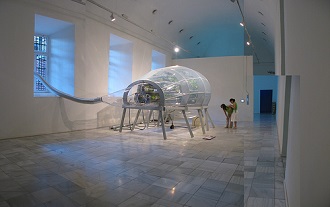
So a while back I met this artist/engineer/satellite designer and otherwise genius professor from New York University, and I instantly started arguing with her. Natalie Jeremijenko (who you can read about on Salon) was talking about technological approaches to climate change, and I just started on my rant about how we can’t wait for new technology and blah, blah, blah, hobbyhorse, hobbyhorse, hobbyhorse.
When I finally decided to listen instead of spout, Natalie told me about her particular interest in the use of technology to empower people towards their own, non-governmental responses to climate change. How can technology be put in the hands of people so they can save the earth without waiting for the politicians to finally realize we have an emergency on our hands? (My words, by the way, not hers.)
Anyway, I wanted to draw your attention to two fascinating pieces of Natalie’s work. One is the Urban Space Station (USS). The idea is that the structure, mounted on the top of buildings (as opposed to in an art gallery like the prototype pictured above), will take the carbon dioxide generated within the building and sequester it in food-producing plants within the USS.
It’s sort of green roof meets food production meets air scrubber (though I’m not sure Natalie would like that characterization). Natalie has in mind that it would be available in kit form so that people across the world could erect it at the top of their own buildings as their own individual-meets-barn-raising response to climate change (read more here).
To quote Natalie:
“What would a bomb/fallout shelter for the climate crisis be like? Shelters were an exceptional practice, erected quickly by the civic sector, and a very local response to an uncertain collective threat. They remain as icons of a sort of the mobilization that achieved with the urgency and exceptional conditions of the war, and provide a comparison to the contemporary civic responses climate crisis (such as change your lightbulb, drive at the speed limit, buy local lettuce). Who designed, built, funded, and deployed those shelters, for whom, and what would one look like now, one that addressed the contemporary threats?”
The other piece of work I wanted to let you know about is her “environmental health clinic.” As it says on her website:
“The Environmental Health Clinic at NYU is a clinic and lab, modeled on other health clinics at universities. However the project approaches health from an understanding of its dependence on external local environments; rather than on the internal biology and genetic predispositions of an individual.
“The clinic works like this. You make an appointment, just like you would at a traditional health clinic, to talk about your particular environmental health concerns. What differs is that you walk out with a prescription not for pharmaceuticals but for actions: local data collection and urban interventions directed at understanding and improving your environmental health; plus referrals, not to medical specialists but to specific art, design and participatory projects, local environmental organizations and local government or civil society groups: organizations that can use the data and actions prescribed as legitimate forms of participation to promote social change.”
What I love about Natalie’s work is that it is wonderfully optimistic and is all about pathways that encourage us to participate in our own lives, our own world and our own culture. It asks us to take charge of our futures, to move beyond the simple “use fewer resources” approach and to do so with fun and vision. It’s the kind of work that inspires you and makes you want to do better.
[ADDED: On top of all that she turns engineering into art and art into engineering and makes which expands and empowers us even more.] You’re going to love this Good Magazine video about her clinic: